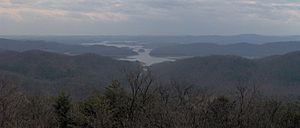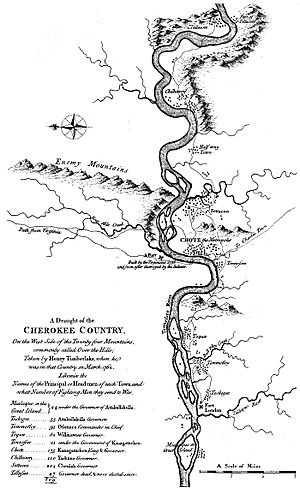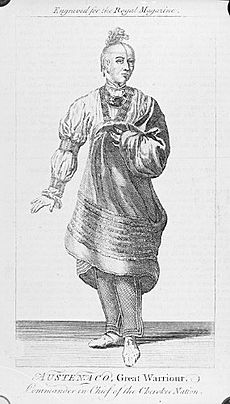Henry Timberlake facts for kids
Quick facts for kids
Henry Timberlake
|
|
|---|---|
| Born | 1730 or 1735 |
| Died | September 30, 1765 |
| Occupation | Military officer, journalist, and cartographer |
| Known for | British colonial emissary to the Overhill Cherokee |
Henry Timberlake (born 1730 or 1735 – died September 30, 1765) was a British-American military officer, journalist, and cartographer. He was born in Virginia and later died in England. He is best known for his important journey as an emissary (a special messenger) from the British colonies to the Overhill Cherokee people. This trip happened during the 1761–1762 Timberlake Expedition.
Timberlake wrote about his travels to the Cherokee in his memoirs, published after his death in 1765. These writings became a key source for understanding the Cherokee culture in the 1700s. His detailed descriptions of Cherokee towns, council houses, weapons, and tools have been very helpful to historians and anthropologists. These details helped them find Cherokee structures and items at archaeological sites in the southern Appalachian mountains. For example, archaeologists used Timberlake's map, called Draught of the Cherokee Country, to find major Overhill village sites before the Tellico Dam was built in the 1970s.
Contents
Early Life and Military Career
Henry Timberlake was born in Hanover County, Virginia. His parents were Francis and Sarah Timberlake. Some records say he was born in 1730, while others suggest 1735. Timberlake wrote that his grandfather, also named Henry Timberlake, was a merchant who traveled to Virginia from England.
After his father died, Henry Timberlake inherited some money. He decided to join the military to support himself. In 1756, at the start of the French and Indian War, he joined a group called the "Patriot Blues." They worked to remove French and Native American raiders from western Virginia. He tried to join the Virginia regiment, which was led by George Washington, but there were no open positions.
In 1758, Timberlake successfully joined the 2nd Virginia Regiment. He became an ensign, which was an entry-level officer rank. He marched with his regiment toward Fort Duquesne (where Pittsburgh is today), but he became ill and could not continue. In 1759, he helped build defenses in the Pittsburgh area.
British-Cherokee Relations and Conflict
In 1760, the good relationship between the British and the Cherokee turned bad. This happened after authorities in South Carolina killed 22 Cherokee leaders who were held captive at Fort Prince George.
Later in 1760, the Overhill Cherokee surrounded Fort Loudoun. This was a British outpost on the lower Little Tennessee River in what is now Tennessee. The Cherokee wanted the British to leave the area. The British soldiers at the fort held out until August but had to surrender because they ran out of food. A British relief force failed to reach the fort. Even though the soldiers left Fort Loudoun under a flag of truce, the Cherokee killed 22 of them as they marched back. This was in return for the earlier killing of the 22 Cherokee leaders in South Carolina.
In 1761, Jeffery Amherst, the British commander, sent a larger force against the Cherokee. William Byrd was ordered to threaten the Overhill towns in what is now Tennessee. Timberlake joined Colonel Adam Stephen in the Holston River valley. They began building a base called "Fort Robinson" to prepare for a march south.
Journey to the Overhill Country
On November 19, 1761, as Fort Robinson was almost finished, about 400 Cherokee warriors arrived. Their leader, Chief Kanagatucko (also known as "Old Hop"), asked for peace. Colonel Stephen agreed right away. Kanagatucko then asked for a British officer to go with him to the Overhill towns. This would show that the fighting had stopped. Stephen was hesitant, but Timberlake volunteered for the journey.
Timberlake traveled with Sergeant Thomas Sumter, an interpreter named John McCormack, and a servant. They bought a canoe and ten days' worth of food. Their plan was to follow the Holston River to the French Broad River, and then go to the lower Little Tennessee River, where the Overhill towns were located.
The group left Long Island on November 28, 1761. The Holston River was very low, so they often had to drag their canoe. After several days, they ran out of food. Luckily, McCormack shot a bear, providing them with meat. Around December 7, they explored a cave. Timberlake described how Sumter swam almost half a mile in freezing water to get their canoe back after it drifted away.
On December 13, the expedition reached dangerous rapids that Timberlake called "Great Falls." They spent a day carefully moving their canoe down the rapids. Downstream, the Holston River was frozen. The ice slowed them down, but rain on December 14 thawed it. On December 15, they reached the Tennessee River (near where Knoxville is today).
Exploring Overhill Cherokee Towns
The deeper waters of the Tennessee River allowed the group to travel much faster. A Cherokee hunting party met them near the mouth of the Little Tennessee River. They gave the tired travelers food like dried venison and corn. The next day, a chief named Slave Catcher guided them up the Little Tennessee River. Timberlake remembered that his hands were so sore from paddling that they were bleeding.
The Timberlake party arrived in the Overhill town of Tomotley on December 20. They were welcomed by the town's leader, Chief Ostenaco. After staying a few days in Tomotley, Timberlake and McCormack went to Chota, the main Overhill town. Many chiefs had gathered in the town's large council house. Ostenaco gave a speech and symbolically buried a hatchet, showing that peace was made between the English and the Cherokee. Timberlake then took part in a peace ceremony, smoking several ceremonial pipes of tobacco with the chiefs. He found this practice "very disagreeable" but participated without complaining.
Timberlake and Ostenaco continued to Citico. There, Timberlake saw a ceremonial dance with about 400 Cherokee. He said the dancers were "painted all over in a hideous manner." The town's chief, Cheulah, gave Timberlake a string of beads and held another pipe-smoking ceremony. Timberlake smoked so much that he felt sick for several hours. The next day, they visited Chilhowee, where a similar peace ceremony took place.
Returning to Virginia
With his mission mostly complete, Timberlake returned to Tomotley with Ostenaco on January 2, 1762. He spent the next few weeks learning about Cherokee customs and making notes for his map. By the end of January, rumors of new fighting with other tribes made Timberlake anxious. He asked Ostenaco to guide him back to Virginia. Ostenaco agreed, and they left on March 10, 1762. Before leaving, Timberlake saw a war party return, singing a "war-song."
The group decided to travel back overland, buying horses from the Cherokee. Ostenaco, with several hundred Cherokee warriors, guided them north along the Great Indian Warpath. On March 11, they reached the abandoned village of Elajoy near Little River. The next day, they crossed the French Broad River. A week later, they arrived at Fort Robinson, which the British soldiers had left but had left behind a lot of flour.
The expedition left Long Island of the Holston on March 22. They continued north to an army camp where Timberlake had left some belongings. He was very disappointed to find his trunk had been robbed. The party traveled through the mountains and finally reached Williamsburg, Virginia, in early April.
Visits to London
While in Williamsburg, Timberlake and Ostenaco attended a dinner party. That evening, Ostenaco said he wanted to meet the King of England. Timberlake worried about the cost, but he agreed to arrange the trip for the chief. In May 1762, Timberlake, Sumter, and three important Cherokee leaders, including Ostenaco, sailed to London.
They arrived in early June, and the Cherokee chiefs became an instant sensation. Crowds gathered everywhere to see them. The poet Oliver Goldsmith waited for three hours to meet them. The chiefs also had their portraits painted by Sir Joshua Reynolds and met King George III. The Cherokee leaders returned to North America in August 1762. Timberlake stayed in England to deal with some money problems. He was appointed a lieutenant in the "42nd or Royal Highland Regiment of foot." This higher pay helped him pay for his trip back to Virginia in March 1763.
After returning to Virginia, Timberlake went to New York to get his military commission. Soon after, he learned that his pay would be cut in half because the Seven Years' War had ended. Timberlake left the military and returned home to Virginia. He asked the government to pay him back for his travel expenses, but they refused.
In the summer of 1764, five Cherokee visited Timberlake. They wanted to meet the governor of Virginia and travel to London. The Cherokee wanted to ask King George to enforce the Proclamation Line of 1763. This line was supposed to stop colonists from settling on Cherokee land. The governor refused their request, but Timberlake agreed to help them. He went with three Cherokee to London in the fall of 1764. Soon after they arrived, the person who was paying for the trip became ill and died. Lord Halifax refused to meet the Cherokee because their trip was not authorized. Timberlake was accused of trying to profit from the public's interest in the Cherokee. The government sent the Cherokee back to North America in March 1765. Shortly after they left, Timberlake was arrested for not paying his lodging bills. He likely wrote his Memoirs while he was in prison.
Family Life
Henry Timberlake had a son named Richard. Richard's mother was Sakinney, a daughter of Chief Ostenaco. In his later years, former chief Ostenaco lived with his grandson, Richard Timberlake. While in London in early 1763, Timberlake married an English woman named Eleanor Binel. They were married on January 27, 1763.
Legacy and Contributions
Timberlake's most important legacy is the journal he kept while living with the Cherokee. This book was published in 1765, probably after his death. The journal is important for two main reasons. First, it is a detailed study of Cherokee society, describing their customs and way of life. Second, it is a historical account that shows how the Cherokee made decisions and how they first reacted to European colonists moving onto their lands.
Timberlake described Cherokee methods of warfare, their farming and hunting customs, religious beliefs, birth and death ceremonies, and marriage traditions. He wrote that the Cherokee government was a mix of "aristocracy and democracy," meaning chiefs were chosen based on their abilities. He also described how the Cherokee built canoes and homes, and the general size and shape of their summer and winter houses. Timberlake's descriptions of the Cherokee council house (a central public building in a typical Cherokee village, often built on an ancient mound) have helped archaeologists find such structures at modern excavation sites.
Timberlake's map, titled A Draught of the Cherokee Country, was published with his journal. On this map, he located all the Cherokee villages on the lower Little Tennessee River. He also provided important information about the size of the villages, their populations, and their leaders. Modern studies have shown that Timberlake's map was very accurate. Both his journal, simply called Memoirs, and his map have been reprinted many times. Timberlake's Memoirs is still considered one of the best firsthand accounts of the 18th-century Cherokee people.




